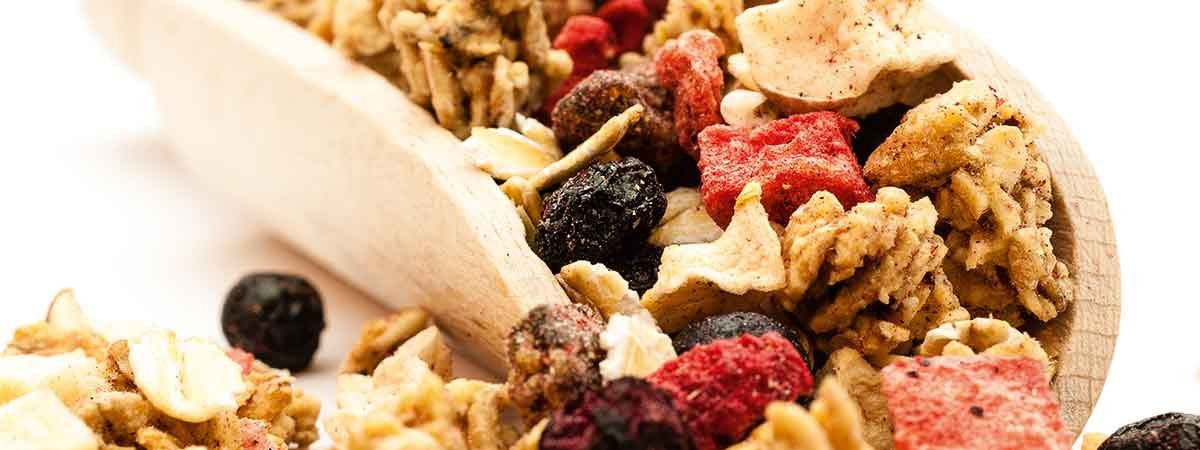Most of the nutrients in food remain intact when the freeze drying process is used. In addition to profound cold, vacuum is a key prerequisite for this gentle process.
Muesli is healthy. It contains whole grains and thus a lot of fibre. Both nutritional value and vitamins and minerals are present in beneficial amounts. It even tastes good. But cutting up fruit early in the morning isn't for everybody. Luckily there are ready-made mixes – all you need to do is add a little bit of milk or yogurt. The grains in cereal already have a long shelf life, which means that their valuable nutrients remain unchanged over time.
But is ready-made muesli as good as homemade? Just a glance at conventional dried fruits shows they are a long way off from the state of fresh fruit. They are not only shrivelled, they've also lost their original colour and a good portion of the vitamins they used to contain.
From ice to vapour
The modern freeze drying process makes it possible to considerably reduce these losses, maintaining the majority of the fruits' vitamins and even colour for mixes with a long shelf life. This is mostly due to freeze-drying. It is based on the physical phenomenon of sublimation, which occurs when a substance directly transitions from a solid to a gas phase. The liquid phase is skipped in this process. For H2O, sublimation means that ice simply evaporates without first becoming water. Of course, this does not happen under normal conditions; it happens in vacuum.
The product to be dried is initially deep-frozen at normal pressure. Supercooled gases like nitrogen or carbon dioxide at temperatures below negative 50 degrees are usually applied in this process. There are two advantages to this: firstly, the cooling process happens very quickly; secondly, no ice crystals are able to form that would change the structure of the frozen product. After the freeze-drying process, the fruits are placed in a vacuum chamber. Now physics can do its work. Without air pressure, the frozen molecules of water in the fruits sublimate or, in other words, evaporate directly.
Showing their colours
It is possible to use this method to remove moisture from foodstuffs without heating them or subjecting them to a lengthy drying process. Valuable nutrients, aromas, vitamins and even colour remain intact. Instead of looking uniformly brown and shrivelled, freeze-dried fruits maintain their original colours. Their consistency also does not change as much. The dry cellular components remain intact as a sponge-like shell. The hollow spaces created during freeze-drying then rapidly take in water again. After they swell up again this way, the products are hard to tell apart from the fresh ones in ideal cases.

Skipping the liquid phase
Vacuum makes sublimation possible during freeze drying
Incas used freeze drying
The indigenous population of the South American highlands was familiar with freeze drying long before the Europeans arrived. The Inca and Aymara people used the process to detoxify potatoes. The types of potatoes used in the early days contained relatively high levels of alkaloids. Alkaloid content in today's varieties is usually limited to the skins. Freeze-drying potatoes to extend their shelf life and ease transport is still a widely used process in the highlands of Chile, Peru and Bolivia.
For a long period of time, the potatoes are exposed to frost at about minus ten degrees and covered with straw during the day. After some time, they are soaked in water and then frozen again. In the end, very shrivelled, lightweight nodules remain. In the Andes, they are called Chuño. Before it is eaten, Chuño is soaked in water. Its volume increases considerably during this process, like rice or pasta products. Mixing it with egg creates a nutritious side dish that is eaten with many of the region's typical meals.
The indigenous population of the South American highlands was familiar with freeze drying long before the Europeans arrived. The Inca and Aymara people used the process to detoxify potatoes. The types of potatoes used in the early days contained relatively high levels of alkaloids. Alkaloid content in today's varieties is usually limited to the skins. Freeze-drying potatoes to extend their shelf life and ease transport is still a widely used process in the highlands of Chile, Peru and Bolivia.
For a long period of time, the potatoes are exposed to frost at about minus ten degrees and covered with straw during the day. After some time, they are soaked in water and then frozen again. In the end, very shrivelled, lightweight nodules remain. In the Andes, they are called Chuño. Before it is eaten, Chuño is soaked in water. Its volume increases considerably during this process, like rice or pasta products. Mixing it with egg creates a nutritious side dish that is eaten with many of the region's typical meals.